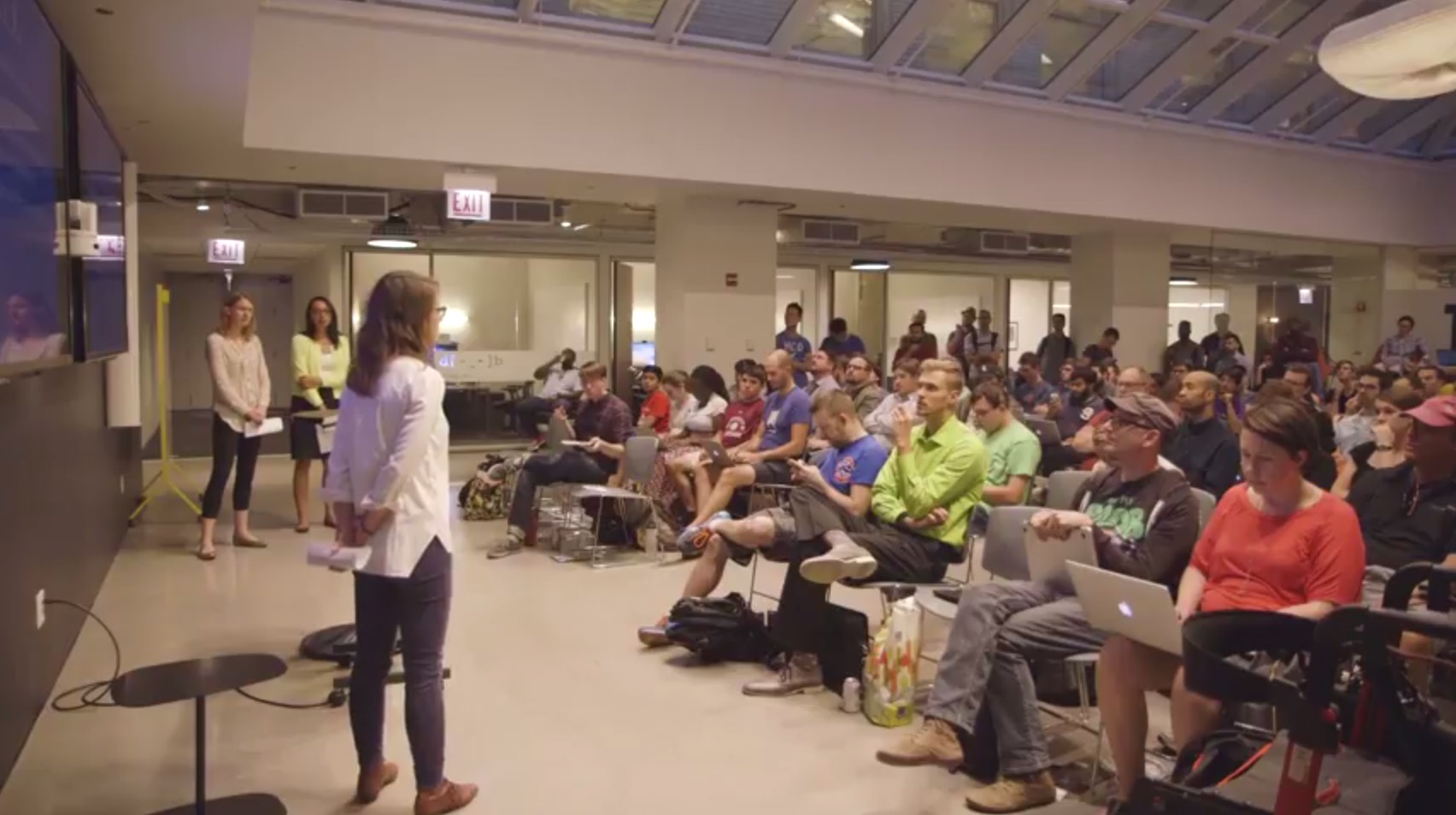The U.S. Government Accountability Office at Chi Hack Night
Published on Sep 16, 2016 by Steven Vance
The GAO hires data scientists, policy researchers, and economists to audit federal government programs.
On Tuesday, September 13th 2016, three analysts from the United States Government Accountability Office presented at Chi Hack Night to describe the data-intensive nature of their work assessing our federal government’s efficiency to a crowd of over 100 people. Presenters Rebecca Abela, Silvia Ellis, and Joanie Lofgren all work in the GAO’s Chicago office, one of 11 offices across the country.
What is the GAO?
The Government Accountability Office, or GAO if you’re into government acronyms, is made up almost entirely of analysts, data scientists, policy researchers, economists, and accountants, and divided into groups working on several key topics. At the Chicago office they have teams dedicated to healthcare, banking, and housing and community investment programs, among other issues. At least one member of each group is an attorney.
The GAO is organized within the legislative branch, and reports to Congress, which created the agency in 1921. They audit government policies to provide options and assessments to Congress about proposed legislation, audit federal programs “to ensure they’re spending funds efficiently and effectively”, Abela said, and provide testimony to Congress. The GAO, Abela added, “gives advice on how to improve those programs”.
In addition to overseeing federal programs, the GAO can also audit the United States Postal Service, and real estate holdings of various agencies.
How the GAO monitors federal programs
About seventy-five percent of the GAO’s work comes from specific requests—from congresspersons, or congressional committees. Some of their investigations are about suspected fraud, waste, and abuse. But the motivation doesn’t have to come from outside. Abela said that the GAO “can initiate our own research”.
Lofgren said that each report comes with some recommendations, and the agency keeps track of which recommendations have been implemented. She said that the agency aims to have 80 percent of their recommendations adopted and “we usually hit that mark”. The GAO’s website reports that in fiscal year 2015, “79 percent of the recommendations GAO made four years earlier had been implemented”.
GAO audits you might be familiar with
Some of the GAO’s reports receive high-profile media attention, but last year they produced over 900, so it’s likely a majority of them weren’t profiled. Many of the reports are mandated by law, making up the remaining balance of how reports are initiated.
In one high-profile example, the GAO audited the federal government’s bank bailout, known as the Troubled Asset Relief Program, or TARP. Ellis described working on frequent reports about AIG, an insurance company that sold credit default swaps which partially caused the Great Recession.
“In 2008, right after the fall of Lehman, the federal government provided $182 billion in assistance to AIG”, Ellis explained. “We came up with risk and repayment metrics” to provide indicators to various congresspersons and federal departments, and to give the public a way to monitor the assistance that went out, and the payments that came back.
The assistance took a lot of forms, including credit lines, AIG stock that the United States Treasury purchased, and “bad assets” that the Federal Reserve acquired. Some of the data that Ellis and her colleagues reviewed included information about AIG securities and their associated filings with the Securities and Exchange Commission, while the Federal Reserve would report on the valuation of their assets. The Treasury would report how much AIG had repaid the credit lines. In all, Ellis said, their reports would “succinctly tell Congress what the repayment looked like”.
All of the reports are made in-house, but the analysts routinely consult and interview subject matter experts, such as academics and industry associations, to collect qualitative information. The GAO may use outside contractors to run focus groups, or to do certain pieces of data analysis; they may also buy data from vendors.
In the Q&A that followed their presentation, someone asked if journalists can “FOIA” – submit a request for information that the Freedom of Information Act allows for – the GAO. The answer was a little surprising.

Rebecca Abela, Silvia Ellis, and Joanie Lofgren from the US GAO's Chicago office
Freedom of information at the GAO
The Government Accountability Office is exempt from the FOIA law, and the reason makes sense. Lofgren said that they follow a “FOIA-like process that follows the spirit of FOIA”. I reviewed their FOIA procedures on the GAO website and they, indeed, have a system for the public, and journalists, to request records. However, it clearly states that the GAO doesn’t release records that meet certain conditions:
-
originate outside of GAO (those requests are referred to the original source);
-
are part of an ongoing review or other current projects; or
-
relate to work performed in response to a congressional request, unless the congressional requester authorizes the release.
Another Chi Hack Night member asked if the public could ask the GAO to start an investigation. Abela said that you’d have to call and ask your congressional representative, and Lofgren added that there’s essentially a triage office that fields requests and sets the GAO’s priorities. “Mandates have a higher priority”, she said.
Tracking the GAO’s recommendations
I said earlier that the GAO reports recommend changes to the relevant agencies. Two people had questions about this. Abela mentioned one example, and explained that while they were reviewing the Veterans Administration wait time controversy, “we told them their data was crap, so they changed it”. Lofgren also described the practice and said that, when an agency hasn’t implemented a change, “we ask the agencies to see what their priorities are” and compare that to what GAO analysts think is important.
These civil servants shared a lot of domain knowledge about their federal agency, but each of the women left the event with a tip on how to join, when an attendee asked “How did you get into this line of work?”
Ellis said she was recruited while attending the University of Chicago, adding that the GAO recruits heavily in Hyde Park. Lofgren said she was in public policy school, and Abela said “we also hire from the industry, especially for our healthcare team”.
Interested in learning more about these government watchdogs? Check out their reports and WatchBlog, all available on gao.gov.
About the author
Steven Vance
Steven Vance is a web developer and transportation planner who writes for Streetsblog Chicago.
